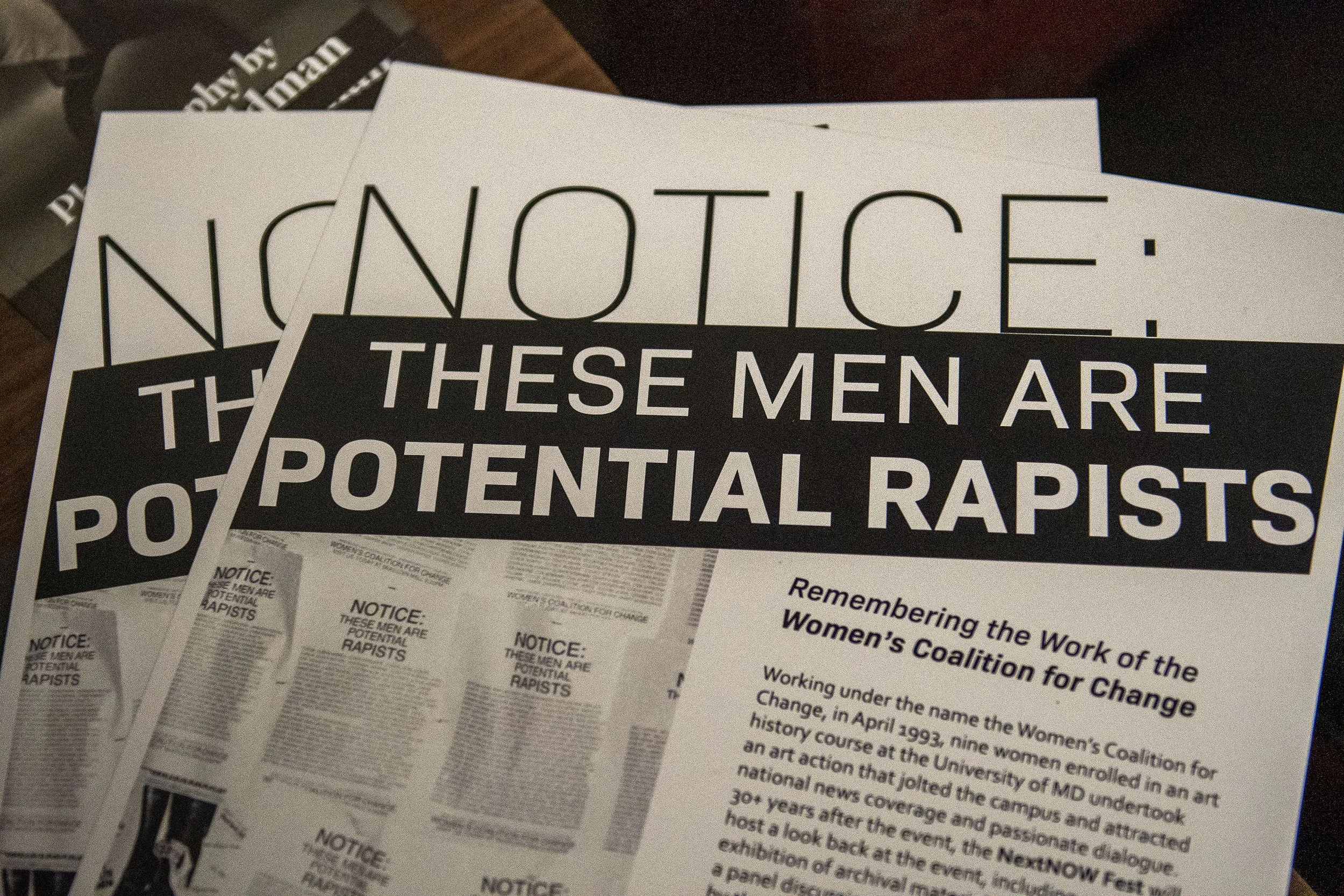New university exhibition reflects on the historic demonstration against rape culture
Fliers promoting last Tuesday’s film screening of “These Men Are Potential Rapists; Remembering the Work of the Women’s Coalition for Change,” sit on a table outside of the University of Maryland, College Park’s Michelle Smith Collaboratory. (Theodore Rose/The Black Explosion)
CONTENT WARNING: THIS ARTICLE CONTAINS MENTIONS OF RAPE AND SEXUAL ASSAULT. Reader discretion advised.
In 1993 the Women’s Coalition for Change, a group of nine anonymous feminist art class students, put up a wall on McKeldin Mall covered with posters reading, “NOTICE: THESE MEN ARE POTENTIAL RAPISTS.” The posters listed every identifiably male name from the student directory. The demonstration, a commentary on rape culture, debuted on April 30 during the university’s annual Art Attack.
Last Tuesday, 31 years later, University of Maryland community members gathered at the Michelle Smith Collaboratory for the opening reception of the exhibition “These Men Are Potential Rapists: Remembering the Work of the Women’s Coalition for Change,” presented by NextNOW Fest. A film screening showing footage of the event was shown at the reception, followed by a panel with the original artists.
Event attendees watch the film screening of “These Men are Potential Rapists; Remembering the Work of the Women’s Coalition for Change,” last Tuesday at the University of Maryland, College Park, Michelle Smith Collaboratory. (Taneen Momeni/University of Maryland’s NextNow Fest).
The film showed archival footage of campus reactions from the day of the demonstration. Hundreds of students gathered on McKeldin Mall to view the piece. WCC enlisted a volunteer to facilitate discourse amongst the crowd. Male students negatively reacted to finding their names on the posters. Some women also expressed criticisms, saying that all people have the potential to be rapists, not just men.
The exhibit, which included three glass cases containing archival pictures, newspapers, and magazines, looks back on the historic public art action. The archival material could be viewed outside of the art library in the Parren J. Mitchell Art Sociology Building.
Three of the original artists spoke at the panel, garbed in masks, hats and sunglasses. The artists remain anonymous to this day to keep the demonstration’s legacy focused on the message and not their personal identity. They engaged in an intimate discussion with a small group of attendees about the exhibit, their recollection of events and their interpretation of its controversial legacy.
The panelists, who were referred to only by codenames Red, Green and Grey, answered questions and asked some of their own, especially about how campus culture has changed surrounding the topic of sexual assault. They expressed their lack of regret and pride in the project, even in the face of the backlash it received.
The screening showed how news of the controversial piece captivated the nation. National coverage of the project, which was intended to be a commentary on rape culture, focused more on the libel accusations leveled against the Women’s Coalition for Change, and their professor Dr. Josephine Withers, by male students and their families.
Acting President Kirwan denounced the WCC students, who have remained anonymous to this day. Male students put out retaliatory posters with messages calling female students “radical feminists” amongst other more vulgar comments such as “Dr. Josephine Withers may be a whore.”
The film also shared a testimony from Lisa Bernstein, a Maryland alum who witnessed the art action firsthand. Bernstein, a graduate student at the time, shared similar opinions on the demonstration's legacy and impact.
“I thought it was an important message because at the time there were a lot of rapes on campus,” Bernstein said. “Also, women were constantly being blamed. Women were being individualized and blamed for being raped.”
Bernstein felt that the poster reframed the issue, shifting the responsibility onto men to stop the culture of gender-based sexual violence. As a mother to a son, she highlighted the need to understand that the society boys are being brought up in values a rapist’s reputation over a woman’s safety.
"It's wonderful that we're looking at this 30 years after. It's terrible that it needs to continue to be looked at,” she said. “But I think that I'm very glad that this happened in 1993 and it needs to continue today, the actions and the discourse.”


